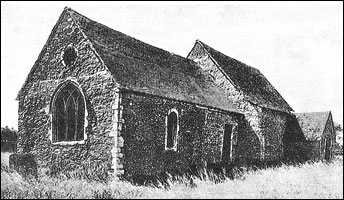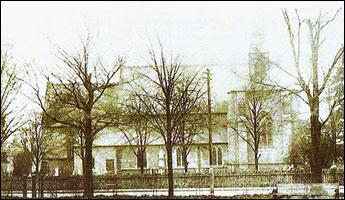![]()
The contents on this page remain on our website for informational purposes only.
Content on this page will not be reviewed or updated.
 |
|
 |
|
|
||||||
|
New Bradwell: Churches and a very 'turbulent priest'
|
||||||
|
||||||
| At St James Church, New Bradwell, in February 1951, the Lord Bishop of Oxford dedicated a new east window. The work, by prominent artist Christopher Webb commemorated various former parishioners and priests of the parish since its foundation in 1860. For many of those present, the most vivid recollections would be of the Reverend Allan Newman Guest, whose local antics had been almost as colourful as the glass in the new window. But in earlier times the most famous of the clergy was the renowned poet John Mason, who served as vicar of the church at Stanton Low from 1668 until 1674. As a small agricultural village, the community had been devastated by the 'enclosure' policy of the then lord of the manor, Sir Nicholas Vaux, who converted some 36 of the Stantonbury acres to sheep farming. As a rich and powerful man, who was a counsellor to King Henry VIII, he had the authority to have 40 people summarily evicted from their homes, and by 1563 only three households remained. A further decline would be evident following the arrival of the railways in the 19th century, when the township that was initially termed Stantonbury, but became more popularly known as New Bradwell, began to be built nearby. The London to Birmingham railway line had been completed in 1838, and with Wolverton chosen as the location to construct both a major station and the central engine works, the urgent need had arisen to acquire land on which to build housing for the workers. However, at Wolverton, the landowning lords of the manor, the Radcliffe Trustees, were unwilling to continue the sale of their acres, and when suitable sites at Stony Stratford, Newport Pagnell and even further afield had been exhausted, the railway company decided to create a new township. In 1852 they purchased not only 15 arable acres lying between the Newport Road and the canal, but also four acres of field next to Bradwell Brook and the Bradwell Road. And with Mr Parnell engaged as the contractor, by the end of 1853 more than 100 terraced dwellings had been built, as well as the Foresters Arms public house. With the railway company now being the major landowner, the new town would eventually become known as New Bradwell. To serve the spiritual needs of the population, the foundation stone of St James Church was laid by the chairman of the LNWR railway company, the Marquis of Chandos, on Monday, May 24,1858. The ensuing construction was undertaken by Mr J. Mills, of Stratford-upon-Avon, to the designs of Mr G. Street, of London, architect of the Strand Law Courts. The costs would total £4,430, partly paid for by subscription, plus a further £1,000 for the provision of a spire and upper tower. On Thursday, December 6,1860, the Bishop of Oxford, addressed the assembled railway workers in the great engine shed and then consecrated the new church. A stone font bearing the inscription 'Presented to God and the service of the Church of St James, Stantonbury, by the Marchioness of Chandos' was placed at the western end of the north aisle. The pulpit was a gift from the engine factory foreman and the workmen of Wolverton. Despite the building of St James Church, services continued to be held at St Peter's Church. The Reverend Allan Newn Guest, 'a strong-willed Irishman who was born in County Kerry in 1862, became the vicar of Stantonbury cum New Bradwell in September 1908. Then, with New Bradwell now well established as a thriving community, on July 1,1909, St Peter's Church was demoted to the status of a chapel. Nevertheless, a restoration took place in 1910, at which an altar and credence table dating from the time of King Stephen was found. However, there would now also be a need to restore the faith of the congregation in their new vicar, for after an evening service in March 1909, he announced that, the 'instrument' necessary to convey the rights and privileges of St Peter's Church at Stantonbury to the new church of St James did not exist. Having been either lost or never made out. Therefore those couples who had been married at Saint James were technically living in sin, conferring an unfortunate status upon any children born of those unions. This naturally caused great consternation, and in 1909 a special Act of Parliament had to be passed to swiftly legalise the hundreds of marriages in question. With the outbreak of the First World War and the consequent sense of national unity, it might be hoped that there would also have been an increased unity between the Reverend Guest and his flock. But sadly this was not to be, and on one occasion some of the congregation even pelted him with hymn books. It was perhaps just as well that he was tall and well built and able to defend himself. Indeed, he had fostered boxing competitions in the vicarage gardens, 'and issued challenges which created a considerable amount of controversy at the time'. However, it was a one-sided attack which led to him being fined £3 for assault at Newport Pagnell Petty Sessions, the summons having been taken out by a lady of Bridge Street, Stantonbury, for beating her 14-year-old daughter. The girl had only just recovered from a bout of pneumonia, and while standing outside her home with some friends the vicar approached, and asked why she did not attend church. She replied that as a member of the Primitive Methodist faith she could not attend, whereupon the vicar retorted: "There is only one church in England, and that is my church," and gave her a vigorous blow on the cheek. The mark was still visible the next morning, and when he later tried to apologise, the girl's mother slammed the door in his face. Not only was he fined, but also ordered to pay the expenses of six witnesses. Apart from such notorious instances, the Rev Guest also became known for championing Sunday gardening, sports and pastimes on Sundays after church service. He threw out a challenge to all comers, 10 years his junior, to swim 100 yards at Wolverton's new bathing place. Unfortunately he lost. After the war, despite the installation of a new organ in 1930, the services at St Peter's Church became ever more occasional, although an increasing interest in the history of the building changed a great deal of excavation to be undertaken between 1930 and 1936. During the Second World War the vicar was in the news again when fined at Stony Stratford Police Court for an assault upon Israel Bloom, an elderly tailor, and his wife. The couple, who were at the vicarage, alleged that the minister had struck them during an argument about an open door. His defence was that, even though five people had been killed when bombs fell locally, he had received little co-operation from the pair in keeping the door closed to prevent light from shining onto the church. It was alleged that the door must have struck Mr Bloom when forcefully closed by the Reverend. A keen archaeologist and historian, 'Father Guest' would remain in the parish until 1946, when, on Sunday, October 6, news of his resignation from the vicariate of the parish of Stantonbury and New Bradwell was posted on the door of St James Church. The living was then entrusted to the Rev E. Steer, vicar of Stony Stratford and Rural Dean. For the past three years the church had been empty on many Sundays, and in the aftermath of this prolonged neglect during the ensuing week a band of willing ladies began a thorough clean of the church interior. Attention was also needed for the churchyard, which had similarly suffered. At the end of October services - now more fully attended - were recommenced, taken by Canon F. Howard, a former vicar of Aylesbury. He had recently retired from the active ministry and lived at Wavendon. As for the Rev Guest, he died in December 1946 at a Bedford nursing home, aged 79, and was cremated at Golders Green in London. |
||||||
|
|
||||||
|
|
||||||


